A Abounaceur1*, J Aitelhaj1 S Laababsi1, A Mchachi1, L Benhmidoune1, R Rachid1, M EL Belhadji1
1Adult Ophthalmology Department, Hospital 20 August, Ibn Rochd University Hospital, Faculty of Medicine and Pharmacy, Hassan II University Casablanca, Morocco
*Correspondence author: Amina Abounaceur, Adult Ophthalmology Department, Hospital 20 August, Ibn Rochd University Hospital, Faculty of Medicine and Pharmacy, Hassan II University Casablanca, Morocco; Email: [email protected]
Published Date: 27-01-2023
Copyright© 2023 by Abounaceur A, et al. All rights reserved. This is an open access article distributed under the terms of the Creative Commons Attribution License, which permits unrestricted use, distribution, and reproduction in any medium, provided the original author and source are credited.
Abstract
Background: Ocular trauma represents an important part of the pathology observed in ophthalmologic emergencies, since it represents about 20% of the reasons for consultation. Ocular damage in cranio-orbital trauma is frequent and constitutes a major but avoidable cause of acquired monocular blindness and poor vision in adults.Thus, the aim of this work is to study the epidemiologic, clinical, therapeutic and evolutionary aspects of this clinical entity.
Patients and Methods: This is a cross-sectional study with descriptive and analytical aims; retrospective over 3 years (January 1, 2019 to June 1, 2022) on 170 files of patients admitted to the ophthalmological emergency department, hospital 20 August 1953 of Casablanca, Morocco, for craniofacial trauma with orbito-ocular damage.
Results: The frequency of ocular involvement was 38.6%. The average age was 27.95 years, with a male predominance (72.3%). Lesions of the anterior segment were more frequent than those of the posterior segment (16.5% versus 4.8%). The prognosis was much better in patients with closed globe trauma (96% without sequelae). Despite this, patients may still have anatomical and functional sequelae.
Conclusion: Cranio-facial-orbital trauma is a public health problem in our context and affects mainly young people. It is urgent to strengthen prevention actions at various levels.
Keywords: Craniofacial-Orbital Trauma; Closed Globe Trauma; Open Globe Injury; Surgical Treatment
Introduction
Ocular trauma represents a significant part of the pathology observed in ophthalmologic emergencies, since it accounts for approximately 20% of the reasons for consultation [1]. Oculo-orbital traumas include a group of injuries to the orbit, the eyeball or the adnexa. They can be contusions, wounds, foreign bodies and burns [1]. These injuries are a real public health problem and affect 55 million people per year [1]. Open eye injuries have an annual incidence of 200,000 new cases and are responsible for approximately 1.6 million cases of blindness and 2.3 million visually impaired [1]. Regardless of the etiology, major oculo-orbital trauma has a poor prognosis and is a major cause of visual impairment and blindness [1,2].
Our objective was to describe the epidemiological and clinical characteristics of oculo-orbital trauma received in the emergency room of the 20 August Hospital in Casablanca.
Materials and Methods
This is a cross-sectional study with descriptive and analytical aims; retrospective over 3 years (January 1, 2019 to June 1, 2022) on 170 records of patients admitted to the ophthalmology emergency department, hospital 20 August 1953, of Casablanca, Morocco, for craniofacial trauma with orbito-ocular damage. All patients with oculo-orbital trauma consulting the ophthalmologic emergency room were included. The examination consisted of an initial interview and inspection of the lesions. It was necessary to measure the distance visual acuity, to examine the traumatized eye with a biomicroscope, to measure the intraocular pressure and to examine the fundus when possible. The variables studied were: age, sex, socio-professional activity, time of presentation to the consultation, laterality, reason for consultation, circumstances of occurrence, traumatic agent, visual acuity and clinical characteristics of the lesions. Ocular trauma was grouped into open and closed globe trauma according to the international classification of ocular trauma “Birmingham Eye Trauma Terminology system” [6]. An eye was considered blind for any distance visual acuity<1/20th and visually impaired for distance visual acuity >1/20th and <3/10th. Statistical analysis of the variables was performed by SPSS 20.0 software.
Results
The frequency of ocular involvement was 38.6%. The average age was 27.95 years, with a male predominance (72.3%). The homeless were the most affected (31.3%), followed by workers and craftsmen with 23.6% (Table 1). Public road accidents were the most common cause of injury (60.8%), followed by assaults (34.5%). Blunt objects were the most represented, followed by sharp objects (Table 2). Pain was the main reason for consultation for 42.8% of patients. Decreased visual acuity in the traumatized eye was the second most common reason for consultation (36.2% of patients), followed by redness (30.1%), the presence of a wound (25.2%) or eyelid swelling (22%). 10.8% of patients were seen within the first 6 hours. The left eye was the most affected (49.3%). Trauma to the closed globe was the most common (73.5%).Rupture of the globe (14.7%) was the main trauma to the open globe (26. 5%) (Fig. 1-6). The most frequent lesions of the adnexa were conjunctival damage and palpebral damage in equal proportions (36.5% and 36.1%), including damage to the lacrimal duct (4.6%) (Fig. 1). In closed globe trauma, the anterior chamber was the most affected structure in the anterior segment (Fig. 2), with hyphaema being the main lesion at 3.9% (Fig. 3). The retina was the most affected structure in the posterior segment at 1.3% (Fig. 7,8). Table 3 shows the main structures injured. The main lesions identified on paraclinical examination were orbital floor fracture and retinal detachment (Fig. 9). The management was multidisciplinary; the treatment was medical in 65% of cases and surgical in 33.5%. Wound suturing was performed in 61.1% of cases, 20.8% of cases had foreign body extraction and 18.1% had been eviscerated (Fig. 4,5,10). One month after follow-up, 6.8% of patients were visually impaired and 8.1% were blind. Nevertheless, the prognosis was much better in patients with closed globe trauma (96% without sequelae).
|
Occupancy |
Number of Cases |
Percentage |
|
Homeless people |
53 |
31.30% |
|
Workers and craftsmen |
36 |
21.50% |
|
Unemployed |
18 |
10.30% |
|
Students |
17 |
9.80% |
|
Drivers |
16 |
9.50% |
|
Shopkeepers |
15 |
8.70% |
|
Administrative staff |
10 |
6.10% |
|
Other |
5 |
2.80% |
|
Total |
170 |
100% |
Table 1: Socio-professional characteristics.
|
Agents |
Number |
Percentage |
Table 2: Nature of the traumatic agent.
|
Structures Affected |
Number |
Percentage |
|
Adnexa |
||
|
Conjunctivas |
62 |
36.50% |
|
Eyelids |
62 |
36.10% |
|
Tear duct |
8 |
4.60% |
|
Orbit |
15 |
8.60% |
|
Anterior segment |
28 |
16.50% |
|
Cornea |
31 |
18.40% |
|
Anterior chamber |
7 |
3.90% |
|
Iris |
3 |
1.80% |
|
Pupil |
2 |
1.20% |
|
Crystalline |
5 |
2.80% |
|
Posterior segment |
8 |
4.80% |
|
Vitreous |
1 |
0.70% |
|
Retina |
2 |
1.70% |
|
Sclera |
1 |
0.50% |
|
Optic nerve |
2 |
1.70% |
Table 3: Distribution of the anatomical structures injured.
Discussion
Oculo-orbital trauma affects twice as many males in our series. This male predominance is found in most series [2-5,7]. According to Macewen, male subjects have more risky behaviours and work in more risky occupations [7]. In our series, the population is young, with 70% of the patients between 15 and 45 years of age, which confirms the data from African series [3,8,9]. Indeed, the young population is also the most active and therefore the most vulnerable. Artisans and workers are the most at risk of having an oculo-orbital trauma. In our context, very few measures are taken to prevent work-related accidents among these workers, most of whom work in the informal sector. Oculo-orbital trauma occurred mainly after road traffic accidents and was mostly due to contusions. Although contusions were the most frequent etiology, trauma due to road traffic accidents, contrary to the African series, was the least frequent in the Caucasian series [3,9-14]. A single eye was traumatized in more than 80% of cases. This tendency to unilaterality is observed in the majority of series in the literature [2-5,8-14]. Beavogui, et al., found similar frequencies; 47.06% for both palpebral and conjunctival lesions. Tchabi, et al., reported a clear predominance of conjunctival lesions (64.9%). Lesions of the anterior segment were more frequent than those of the posterior segment at 16.5% versus 4.8%. The anterior chamber was the most affected structure in the anterior segment with hyphaea as the main lesion at 3.9%. Mittal, et al., in India found a similar frequency of 3.2% while Tchabi, et al., found a lower frequency of 1.1%. The retina was the most affected structure in the posterior segment at 1.3%. Tchabi, et al., in Cotonou found a similar frequency of 1.5% while Agrawal, et al., in India reported 46.6%. This very high frequency is due to the fact that this study was performed only on open trauma of the eyeball. Beavogui, et al., observed 67.45% medical management and 32.25% surgical treatment. A total of 18.1% of patients underwent mutilating surgery, 6.8% had visual impairment and 8.1% had blindness. The severity of the prognosis is often due to the violence of the trauma, the delay in treatment and the nature of the injury.
Conclusion
Cranio-facial-orbital trauma is a public health problem in our context and affects mostly young subjects. Visual impairment and unilateral blindness are not uncommon after these injuries. It is urgent to reinforce prevention actions at various levels.
Patient Consent
Patients provided written informed consent for publication and the use of their images.
Conflict of Interest
The authors have no conflict of interest to declare.
References
- Négrel AD, Thylefors B. The global impact of eye injuries. Ophthalmic Epidemiol. 1998;5(3):143-69.
- Thylefors B. Epidemiological patterns of ocular trauma. Aust NZJ Ophthalmol. 1992;20:95-8.
- Koki G, Epée E, Omgbwa Eballe A, Ntyame E, Mbogos Nsoh C, Bella AL, et al. Les traumatismes oculaires en milieu urbain came¬rounais : à propos de 332 cas évalués selon l’Ocular Trauma Score. J Fr Ophtalmol. 2015;38(8):735-42.
- Bella-Hiag AL, Mvogo CE. Childhood oculo-orbital trauma at the Laquintinie hospital in Douala (Cameroon. Cahiers d’études et de recherche francophones/Santé. 2000;10(3):173-6.
- Eballe AO, Gilles LK, Bella LA. The ocular traumas of l. child consultant at L. gyneco-obstetric and pediatric hospital of Yaounde: epidemiological aspects. Clinics in Mother and Child Health. 2006;3(1):433-6.
- Kuhn F, Morris R, Witherspoon CD, Mester V. The Birmingham Eye Trauma Terminology system (BETT). J Fr Ophtalmol. 2004 ;27(2):206-10.
- Macewen CJ. Eye injuries: a prospective survey of 5671 cases. Br J Ophthalmol. 1989;73:888-94.
- Lam A, N’diaye MR. Ocular trauma in Senegal, epidemiological and statistical report of 1872 cases. Black Afr Medicine. 1992;39(12):810-5.
- Ayena KD, Agbo AR, Abalo A, Hounkpati HE, Djagnikpo PA, Ameke L. Les traumatismes oculaires à Lomé. Médecine d’Afrique noire. 2009;56(5):261-6.
- Tchabi S, Sounouvou I, Yehouessi L, Facounde F, Doutetien C. Ocular contusions at the Cotonou, Benin, National University Hospital. A series of 654 cases. J Fr Ophtalmol. 2010;33(7):450-4.
- Omgbwa Eballé A, Mbassi Ndocko E, Robert Ebana S, Ngong Mbella L, Ebana Mvogo C. Les traumatismes oculo-orbitaires dus aux acci¬dents de motos taxis à Douala au Cameroun. J Fr Ophtalmol. 2016;39(7):596-602.
- Karaman K, Gverovic-Antunica A, Rogosic V, Lakos-Krzelj V, Rozga A, Radocaj-Perko S. Epidemiology of adult eye injuries in Split-Dalmatian county. Croat Med J. 2004;45:304-9.
- Smith D., Wrenn K. The epidemiology and diagnosis of penetrating eye injuries. Acad Emerg Med. 2002;9:209-13.
- Frau E. Traumatismes par contusion du globe oculaire. Ophtalmologie. 1996:21-700.
Article Type
Research Article
Publication History
Received Date: 25-12-2022
Accepted Date: 20-01-2023
Published Date: 27-01-2023
Copyright© 2023 by Abounaceur A, et al. All rights reserved. This is an open access article distributed under the terms of the Creative Commons Attribution License, which permits unrestricted use, distribution, and reproduction in any medium, provided the original author and source are credited.
Citation: Abounaceur A, et al. Ocular Damage in Craniofacial-Orbital Trauma: About 170 Cases. J Ophthalmol Adv Res. 2023;4(1):1-8.
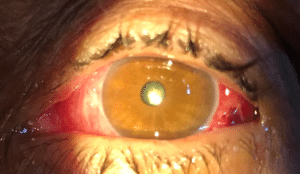
Figure 1: Ocular redness and subconjunctival hemorrhage.
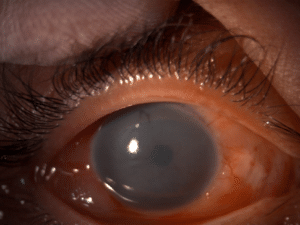
Figure 2: Ocular burn.
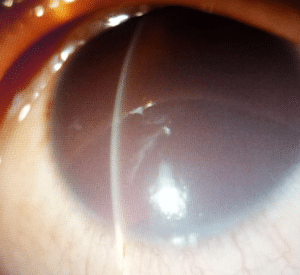
Figure 3: Total Hyphaema.
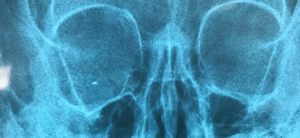
Figure 4: Orbital X-ray showing an intraocular foreign body.
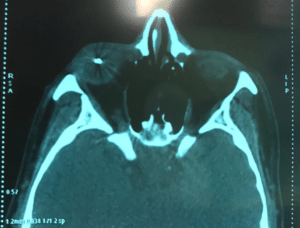
Figure 5: Foreign body objectified by orbital scanner.
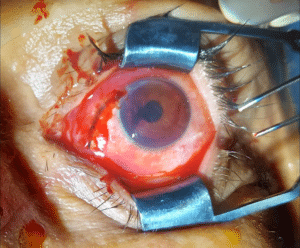
Figure 6: Corneo-scleral wound.
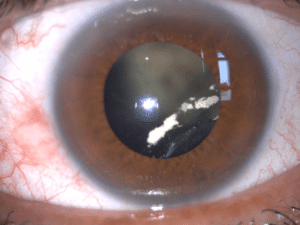
Figure 7: Retinal detachment.
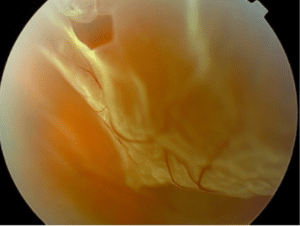
Figure 8: Retinal detachment
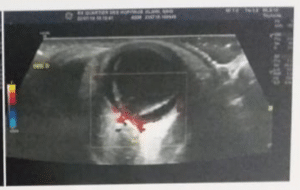
Figure 9: Ocular ultrasound showing retinal detachment.
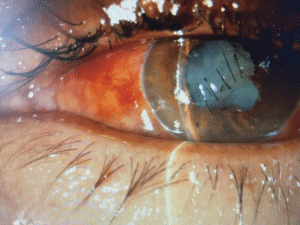
Figure 10: Surgical treatment by suturing the wound.
Occupancy | Number of Cases | Percentage |
Homeless people | 53 | 31.30% |
Workers and craftsmen | 36 | 21.50% |
Unemployed | 18 | 10.30% |
Students | 17 | 9.80% |
Drivers | 16 | 9.50% |
Shopkeepers | 15 | 8.70% |
Administrative staff | 10 | 6.10% |
Other | 5 | 2.80% |
Total | 170 | 100% |
Table 1: Socio-professional characteristics.
Agents | Number | Percentage |
Table 2: Nature of the traumatic agent.
Structures Affected | Number | Percentage |
Adnexa | ||
Conjunctivas | 62 | 36.50% |
Eyelids | 62 | 36.10% |
Tear duct | 8 | 4.60% |
Orbit | 15 | 8.60% |
Anterior segment | 28 | 16.50% |
Cornea | 31 | 18.40% |
Anterior chamber | 7 | 3.90% |
Iris | 3 | 1.80% |
Pupil | 2 | 1.20% |
Crystalline | 5 | 2.80% |
Posterior segment | 8 | 4.80% |
Vitreous | 1 | 0.70% |
Retina | 2 | 1.70% |
Sclera | 1 | 0.50% |
Optic nerve | 2 | 1.70% |
Table 3: Distribution of the anatomical structures injured.


